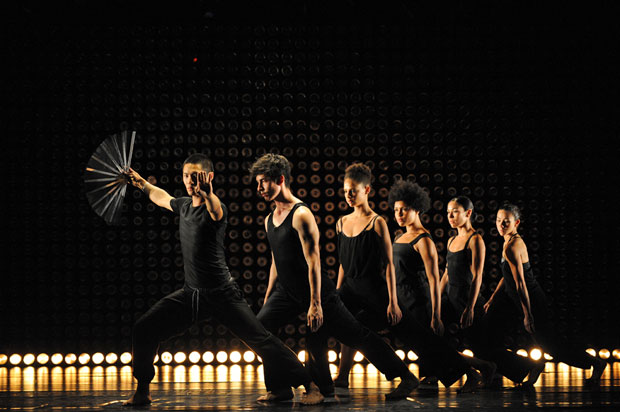
© Branco Gaica. (Click image for larger version)
Shaun Parker & Company
AM I
at Melbourne Festival 2014
Melbourne, The Coopers Malthouse
23 October 2014
www.shaunparkercompany.com
www.melbournefestival.com.au
“Once upon a time, before time was time…”. This is the opening intonation by Shantala Shivalingappa, the narrator of Shaun Parker & Company’s latest work, AM I. From the first text, it is clear that AM I is seeking to tackle enormous, totemic, even epic, themes. Ranging from The Big Bang and the biological imperatives of survival and procreation through to individual spirituality, human physiology and the quasi-religion that is social media, AM I is a thematic magpie, shifting from the macro to the micro and back again in its exploration of the nexus of religion and science.
The set, by lighting designer Damien Cooper and Shaun Parker, features a wall of lights behind the dancers. These are not delicate LEDs, but large heat lamps that wink in and out of existence in complex, computer-driven patterns. Using this set feature, the representation of the Big Bang is particularly powerful: all the lights come on in a blinding flash, sending a wave of heat into the audience and creating a visceral sensation of the shock, burning and birth of our universe. Above the wall of lights, musicians and singers perform on an elevated dais. Nick Wales composition draws from a range of different sound themes with sequences that are tribal, weaving together threads of what seem to be traditional African, Middle Eastern or Indian rhythms, aiming to capture the universal rather than the specific. It is stirring stuff, particularly with the vision of musicians forming a lofty pantheon overlooking the human action onstage, a visual contrast of the spiritual with the worldly.
Wales is successful in integrating different movement themes in the sound score, but it is not a success that is consistently shared in Parker’s choice of text. In his program notes, Parker refers to books including Jared Diamond’s Guns, Germs and Steel, Alain de Botton’s Religion for Atheists, Michael Talbot’s The Holographic Universe and texts by Freud and Jung among many others. From these resources Parker has mined a ream of trivia, existential ideas and powerful statements about the relationships between man and world. There is curiosity in the choices but, surprisingly, little poetry. There is little sense that these ideas have been woven with the kind of deftness Wales has brought to his musical composition, almost as though the vastness of their themes rendered them immune to reconfiguration.

© Prudence Upton. (Click image for larger version)
Shivalingappa (an artist who has worked with Maurice Bejart, Pina Bausch and Ushio Amagatsu) serves as narrator, responder and sometimes instigator of the action. Her words are matched with precise hand gestures, the articulated finger shapes perhaps drawn from Kathakali Mudras and highly expressive in form and sequence. The most successful moments in the work come when Shivalingappa’s actions seem to trigger patterns in the wall of lights. Shivalingappa and performer Julian Wong are often placed outside the dancers, standing and watching from the side of the stage. Wong’s background in shaolin gongfu, baguazhan (Chinese martial arts) and circus fire twirling are used to great effect, with Wong wielding a metallic fan like a weapon.
Parker’s choreography for the seven performers revolves around terms of cause-and-effect, with popping and locking as one of many physical languages. There are parallels in Parker’s choreography to stop-motion animation, at least in the use of incremental movements to create a larger visual picture. Gestures cascade like dominoes, with one hand motion triggering an immediate response of another, passing information from dancer to dancer like a complex network of synapses. The spaces between action and reaction are tight and transparent, and although we never know what gesture will come next, we do become accustomed to this kind of reactive choreographic thinking. Often the structures are enormously effective but, as with the text Parker has chosen to work with, the balance of literal and abstract is not fully explored.
The dancers in AM I utilise props to extend the impact of each gesture. Metal batons become floating tracings in the air, allowing for shapes and forms to be built like a scaffold extending outwards from the lower arms of the bodies. These sequences are incredibly detailed and carefully constructed, highly dependent on each dancer hitting the mark to create the larger visual picture. The impact is of individual subjugation for group success; a telling analogy for the theme of the survival of the human species. Interestingly, and despite the kind of effort that Parker has put into the creation of the movement, AM I feels strangely static. This is a work that strongly privileges gesture and the upper body, which makes the lack of development in the rest of the choreography apparent. When the dancers spin away from their tight formations, the little detail and complexity in their movement causes an uneasy imbalance across the work. In the same way that Shivalingappa’s role never makes clear whether she is within or outside the world Parker has created, there is an ambivalence here about the purpose of movement. Black jumpsuits and pants (with a black floor) make articulating the detail in the movement even more difficult, although they do serve to remind us that the dancers are perhaps representing part of a system, rather than individuals in their own right.
Despite its totemic themes, and even though the text tries to take the narrative from the universal to the individual, this is a work that seems uncomfortable with the emotionality of the human experience. In his solo, dancer Josh Mu uses facial expressions and hand gestures to demonstrate rage, fear and vulnerability. The bottom half of his body, however, rocks from side to side. It is, perhaps, a stable base from which these emotive gestures can sprout. However, it is also an analogy for a work that has not quite found a way to integrate big ideas through full, physical movement.
AM I is a work that feels like it needed one more period of development to truly find its feet choreographically, although the success of the set and the musical composition, as well as Parker’s ambition, demonstrates an enormous amount of artistic promise.







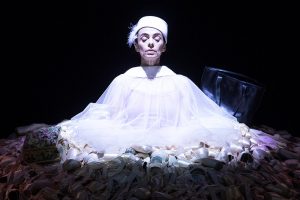


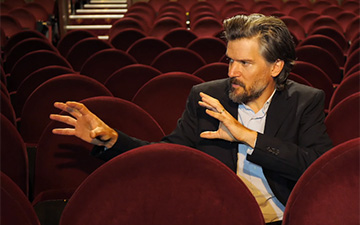

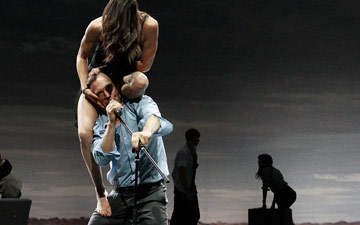
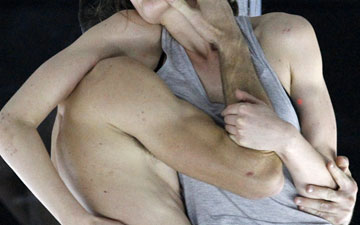


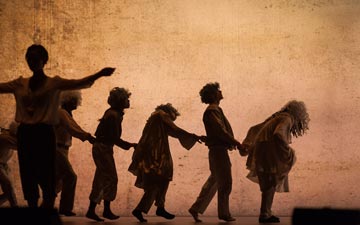
You must be logged in to post a comment.